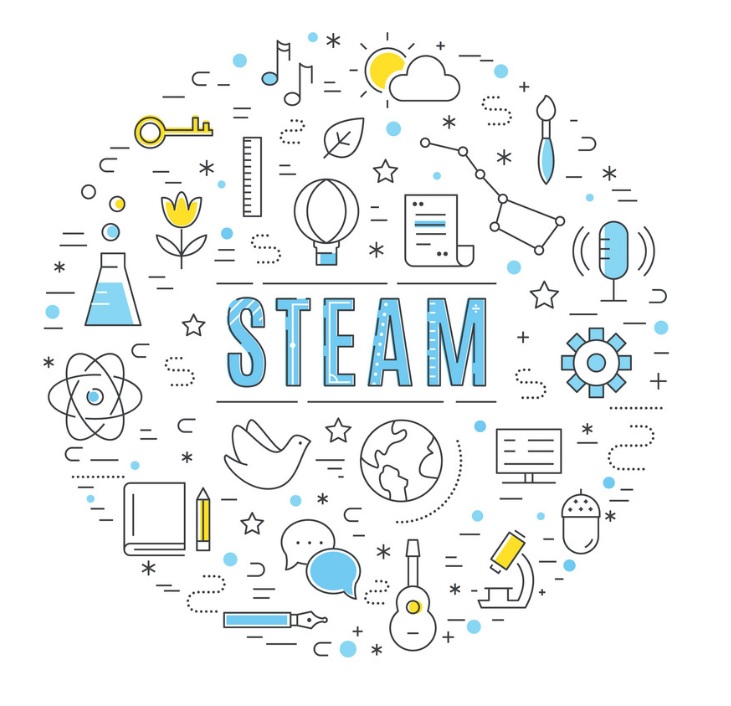
Definition of STEAM in Education: STEM + Art = STEAM
In the education domain, the acronym STEAM comes from five initial characters of Science, Technology, Engineering, Art, and Mathematics. Coined around 2013, STEAM is a movement widely adopted by institutions and corporations. The schools are teaching science and math along with the arts, for example, students had to build their own cameras as an assignment of their photography class.
On the personal level, almost every parent is the first art-teacher of his/her child: remember the lullaby that you hum to put the baby to sleep, or the stick-man you drew with the kid to help storytelling? The art (music and painting) is there at the beginning of the education.
It is the objective of STEAM to transform research policy to place art and design at the center of STEM (science, technology, engineering, and mathematics); encourage the integration of art and design in education; and influence employers to hire artists and designers to drive innovation.
What does STEAM truly stand for?
STEAM symbolize the harmony between science and art. On the surface, science and art seems different: science is in pursuit of answers while art is looking for questions. However, a little bit deep thinking would lead to the common-factor of these two fields: Creativity. The characteristic behaviors shared by both are research, observation, experimentation, discovery, and innovation.
STEAM education stimulates the learner to be creative. Learning Augmented Reality is a very good example, which interweaves science and art naturally. Not only the kids have to create a storyline that makes physical and scientific sense, they also need to present his project to peers with appealing visual effects. The spaceship carrying creative young-adults shows a subtle bumpy behavior in the virtual environment make it feel so real, due to the imitation of aerodynamics.
How would art education complement STEM and make it complete?
The brain is divided into two hemispheres: left brain is connected to logic and mathematics; right brain is in charge of imagination and arts. STEM may solely put emphasize on the left brain, but STEAM matches both and completes a perfect pair.
Manufacturing an electric car requires a lot of STEM trained engineers, without question. However, the popularity and the crown of best-selling of Tesla model 3 doesn’t get its fame only from a list of technical features. The really nice-looking, clean design makes it instantly acceptable. Electric car is just one example. In general, appearance or user-experience design along with technical advantage affect a product’s success in a highly competitive market.
STEAM cultivate skills in-demand for future
Technology proceeds so fast thanks to the huge investment in artificial intelligence (AI), and future jobs will look vastly different from the current form. Machines will do human a favor by handling the physical demanding, time-consuming, tedious tasks, and leave the interesting problems to human for them to explore, experiment and construct innovative solutions.
However, it doesn’t come for free. There are 7 skills required to land a job of the future. STEM is one them, and the rests are Creativity, Critical thinking, People-skill, Mental elasticity and complex problem solving, SMAC (social, mobile, analytics and cloud), and Interdisciplinary knowledge. As you may notice, regarding the number of skills, the right brain plays a more significant role than the left brain.
For the sake of being concise, let’s just focus on people-skill at the moment. Do you teach your son or daughter how to listen, how to get in touch with other’s emotions, how to show empathy? This kind of knowledge is hard to be summarized and conducted using a rigorous formula (in a STEM approach), because, as you may understand, it is an art. Interestingly, augmented reality has been applied in education, such that students learn to care for others, and its combination of technology and art-design has shown to enhance the empathy of the kid and help them fight bullying.
Thus, fear no more the AI of the autonomous machine. Instead, STEAM-ulate the youngsters to gain the skills in-demand and they will be ready for their future.
STEAM jobs
Let’s look at job market. In the era of information technology, there are several waves of job demand in the following domains: semiconductor design and manufacturing, internet and web architect, e-commercial, social media, and the on-going artificial intelligence and internet-of-things. These industries require a lot of skilled workers, programmer and engineers. With the high growth, the workforce in these industries was rewarded with high salary. Without much time to ponder, parents want to pave a road for their kids, such that STEM education can lead them to the entrance of these fields, in other words, being successful job applicants.
A recent survey of U.S. employers found that creativity is one of the top three personality traits most important to career success, where 72% of employers said that creativity is of primary concern when they are hiring. Yet 85% of those employers can’t find the creative applicants they seek. The arts integrate concepts from all of the STEM subjects while allowing students to develop their creativity and problem-solving skills. Art programs provide a rare opportunity for students to incorporate knowledge from all core subject areas while helping them to feel motivated, engaged, and creative.
Using Augmented Reality/Virtual Reality (AR/VR) technology as an example, undoubtfully, it is a technology of future trend. In order to create high quality AR/VR experience, learners are forced to integrate art, technology, science, engineering, and math smoothly for final consumption. In other words, for AR/VR application, STEAM is a must-have.
In summary, STEM education prepares job applicants, and STEAM makes them outstanding for the future.
Now Integem Holographic AR Design and Programming STEAM Camp is open for registration. Learn more here: https://camp.integem.com



Recent Comments